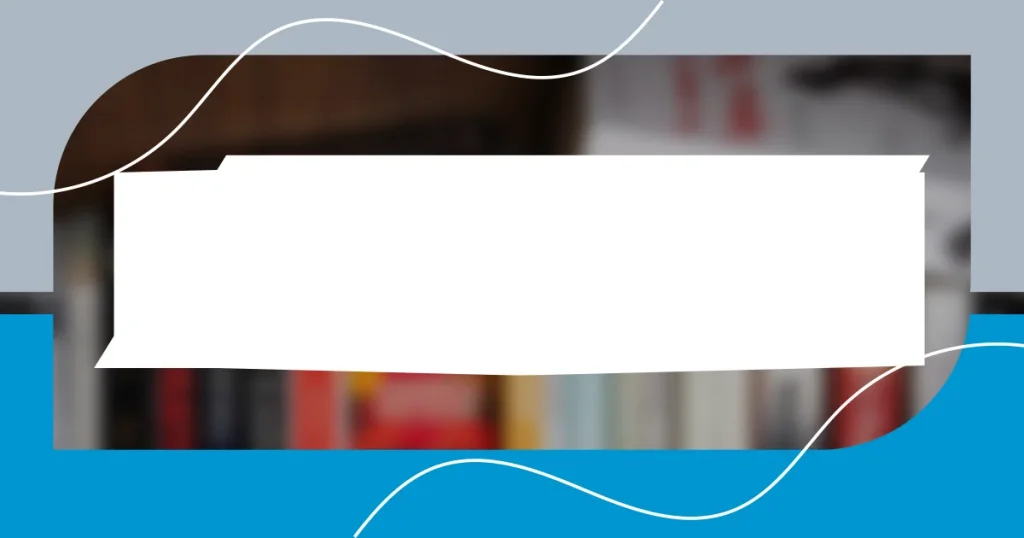Key takeaways:
- Understanding genre conventions, tone, and audience expectations is essential for writers to create impactful connections with readers.
- Adapting writing structure and vocabulary based on genre enhances storytelling, allowing the writer to resonate more deeply with the audience.
- Practicing adaptability across genres fosters empathy and personal reflection, enriching the writing process and the writer’s connection to their work.

Understanding different writing genres
Understanding different writing genres is crucial for any writer looking to connect with their audience. Each genre has its own conventions, tones, and expectations. For instance, I remember the first time I tried my hand at writing poetry. The freedom and emotional depth were thrilling, but I quickly learned that in poetry, every word carries weight, unlike the more straightforward approach in technical writing.
When I transitioned to crafting short stories, I realized how vital narrative structure is. The need to build characters and create a plot twist can be exhilarating. But it also triggered moments of self-doubt. How can I make my characters relatable yet unique? It’s a balancing act that requires understanding the genre’s nuances.
Then there’s the challenge of adapting to the tone required for different audiences. An academic piece demands formality, while a personal blog invites a conversational style. I often ask myself: “How do I want my readers to feel?” This kind of reflection can profoundly shape my writing, making it a more dynamic and rewarding experience.

Identifying key genre characteristics
Identifying the key characteristics of a writing genre can feel like piecing together a puzzle. Each genre has distinct elements that dictate not just what to write but how to write it. For instance, I remember diving into mystery writing, where the art of suspense looms large. Ensuring every clue is subtle yet impactful is key; it’s like leading a dance where each step must be carefully choreographed.
Here are some essential genre-specific traits to consider:
- Tone: Determines the emotional quality (formal vs. casual).
- Structure: Refers to organization (chronological vs. circular narratives).
- Character Development: Reflects depth and relatability (flat vs. dynamic).
- Language Style: Varies from technical jargon to lyrical prose.
- Themes: Central messages or ideas (love, justice, conflict).
Being mindful of these traits has enhanced my writing significantly. I once tried my hand at romance, and I could feel the gentleness in my word choice influencing the emotional connection. It’s fascinating how acknowledging these characteristics can elevate the impact of your work, making it resonate with readers on different levels.

Adapting tone for each genre
Adapting the tone for different genres can feel like switching hats—what works in one genre may not fly in another. When I ventured into writing horror, I found that cultivating a sense of dread and unpredictability was crucial. I remember crafting a chilling scene where even the smallest details, like an ominous creak of a floorboard, sent shivers down my spine. The tone needed to be tense and foreboding to immerse readers in that unsettling atmosphere.
In contrast, writing a children’s book brought a completely different set of challenges. I had to tap into a playful and imaginative tone, one that could spark joy and curiosity. I recall weaving in rhymes and whimsical characters; it was a joyous experience that reminded me of my own childhood adventures. Adjusting the tone to be light-hearted and engaging allowed me to connect effortlessly with my young audience, demonstrating how important it is to match the tone to the genre’s expectations.
This fluidity in tone, from eerie to whimsical, showcases our adaptability as writers. It allows us to tap into deep emotional realms of experience and expression. When I craft a piece, I often check in with myself, asking: “Does this truly resonate with the genre’s vibe?” Making these tonal adjustments not only enhances the reader’s experience but also challenges me creatively, and that’s where the magic happens.
| Genre | Tone |
|---|---|
| Horror | Tense, foreboding |
| Children’s Book | Playful, imaginative |
| Academic | Formal, precise |
| Romance | Gentle, emotive |

Modifying structure by genre
When I adapt my writing structure based on genre, it often feels like constructing a tailored outfit for a specific occasion. For example, while writing a thriller, I’m careful to space chapters and scenes to maintain a quickened pulse in the reader. It’s like pacing a race; I focus on short, punchy sentences that jolt the reader into action. I remember structuring a chase scene with fragmented sentences, reflecting the urgency and chaos of the moment. It’s fascinating how just the arrangement of sentences can elevate the tension.
Conversely, when approaching literary fiction, I find myself lingering in longer passages, diving into rich descriptions and deeper character introspection. I recall crafting a scene where a character sat quietly by a lake, allowing the narrative to unfurl slowly. The structure was almost meditative, painting vivid imagery and emotions that required space to breathe. This deliberate pacing welcomed readers into a reflective state, inviting them to savor the moment and feel the depth of connection.
It’s intriguing to consider how the structure twists and turns depending on the genre as a whole. I often ask myself, “What structure best captures the essence of this story?” That question fuels my creativity and guides the shaping of my writing. Whether I’m racing against time in a suspenseful piece or exploring the nuances in a character-driven narrative, adjusting my structure becomes not only a technique but a way to connect more profoundly with readers.

Incorporating genre-specific vocabulary
When I write within a specific genre, I notice how essential it is to weave in vocabulary that resonates with the conventions of that genre. For instance, when delving into science fiction, I find myself researching terms related to technology and space, as these details not only enhance authenticity but also immerse readers in the futuristic setting. I remember scribbling notes about advanced robotics and parallel universes, eager to find the exact phrases that would make my world-building feel credible.
On the flip side, writing historical fiction often involves a different set of words and phrases. I feel an exhilarating challenge when I look for vocabulary that reflects the era I’m depicting. Recently, while working on a story set in the Victorian era, I immersed myself in period slang and fashion terminology to create a richer experience. It was fascinating to see how a simple word choice could transport the reader back in time, evoking the nuances and societal norms of that age. Have you ever felt the power of a well-chosen word? It’s incredible how it can shape not just the narrative, but the entire atmosphere of a piece.
Moreover, I’ve found that incorporating genre-specific vocabulary is like adding spices to a dish; it can elevate the overall flavor. While writing a romance, for example, I gravitate toward words that evoke emotion and intimacy. I often catch myself playing with metaphors related to love, using phrases that create warmth and connection. This thoughtful selection of vocabulary not only engages readers but helps them forge a bond with the characters. It’s not merely about understanding the genre; it’s about crafting an experience that lingers long after the last page has been turned.

Using examples for genre adaptation
Using examples to adapt my writing style by genre has proven to be a transformative process. When crafting a fantasy novel, for instance, I often pull from fantastical elements deeply rooted in mythology. I recall a moment when I chose to incorporate a mythical creature, drawing parallels between it and the protagonist’s struggle. This choice wasn’t just about adding flair; it solidified the thematic resonance of the tale and allowed readers to connect more intimately with the protagonist’s journey. Aren’t those layers of meaning what we often seek?
In contrast, exploring the nuances of horror writing demands an entirely different approach. I remember a time writing a chilling short story where I deliberately avoided graphic descriptions and instead leaned into the psychological terror of the unknown. By illustrating the protagonist’s escalating anxiety and paranoia, I crafted a suspenseful atmosphere that lingered in readers’ minds long after the last sentence. It felt like a delicate dance; how do you provoke fear without spelling it out? I learned that in horror, subtlety often amplifies the impact.
Lastly, I’ve noticed that when I delve into young adult fiction, the characters often require a voice that resonates with a specific age group. I vividly recall crafting dialogue that mirrored the slang and social ideals of teens. By weaving in examples from contemporary culture—like references to social media or current music trends—I was able to create a relatable and authentic experience. Isn’t it rewarding to see how these little choices can bridge the gap between characters and readers, making them feel seen and heard in the narrative?

Practicing adaptability across genres
Practicing adaptability across genres is like tuning an instrument to produce the perfect melody. When I write for different audiences, I take the time to immerse myself in the styles and themes that define each genre. For example, I recall shifting gears from writing a gripping thriller to penning a light-hearted cozy mystery. Adjusting my tone was essential; the former needed a sharp edge while the latter embraced whimsy and charm. Have you ever felt the thrill of changing your writing hat?
One of my most eye-opening experiences came when I tackled writing a memoir. Here, I learned to embrace vulnerability, stripping away the layers of fiction. I remember sharing snippets of my childhood that felt raw and unfiltered—like the moment I faced a difficult family dynamic. Crafting this narrative required a balance between honesty and storytelling. It made me wonder: how much personal truth are we willing to expose to connect with our readers?
As I move across genres, I find that each transition is a practice in empathy. Writing a narrative around cultural identity made me deeply reflect on my values and experiences. I once penned a story that explored my own heritage, and that process pushed me to consider how cultural nuances would resonate with others. I began to think about the experiences of the readers—what parts of my narrative would strike a chord? This connection transforms the writing process into an exciting conversation across the barriers of genre and experience.
















